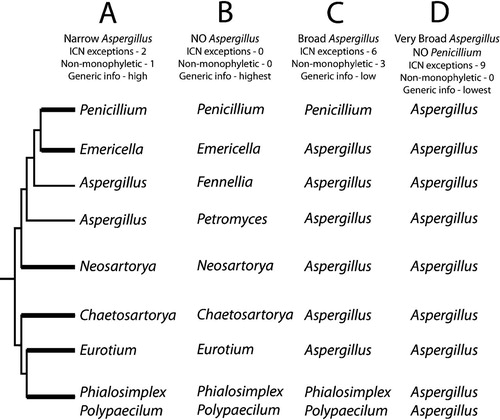Figures & data
Table I. Some phenotypes of the sexual genera associated with Aspergillus
Table II. Fungi, culture numbers and genes sequence accession numbers
Table
Table
Table
Fig. 1. Bayesian and maximum likelihood phylogenetic analyses of Aspergillus and related taxa made with four genes: the RPB1 and RPB2 subunits of RNA polymerase II, Tsr1, a putative ribosome biogenesis protein and Cct8, the putative chaperonin complex component, TCP-1. Numbers above internal branches are Bayesian probabilities; numbers below are maximum likelihood bootstrap percentages. Taxon names correlate with those in . An asterisk marks the end of the exceptionally long terminal branch leading to Emericella nidulans 112.46. Clades are named for Aspergillus subgenera (left column) and for sexual genera (right column) as described in the text. Branch lengths are proportional to genetic distances among taxa. Details of phylogenetic analysis are in Materials and methods.

Fig. 2. Effect of the choice of teleomorph or anamorph names on appeals for exceptions to the ICN priority rule, non-monophyly of genera and information content of the generic names. Phylogenetic cartoon with strongly-supported branches thickened, based on the phylogeny presented in . A. A narrowly defined genus Aspergillus. The ICN must be asked for approval to apply the name Aspergillus to the non-monophyletic grade embracing Petromyces and Fennellia. The information content of the genera would be high because each name embraces one monphyletic clade or, in the case of Aspergillus, a small grade. B. Abandon the genus Aspergillus by applying the teleopmorph name to every clade. This approach is fully compliant with the ICN, and all names would be applied to monophyletic clades. The information content would be high. However, the name Aspergillus would be lost to mycology. C. Apply the name Aspergillus broadly to all clades having Aspergillus anamorphs. Six exceptions to the ICN would be needed. Aspergillus would be made non-monophyletic by the inclusion of Penicillium, Phialosimplex and Polypaecilum. The information content of the name Aspergillus would be low due to the large phenotypc variation found among the six clades bearing the name Aspergillus. D. Make Aspergillus broad by applying the name to species in the genera Penicillium, Phialosimplex and Polypaecilum. Nine exceptions to the ICN would be needed, but Aspergillus would be monophyletic. The information content of the name Aspergillus would be low, due to the extreme phenotypic variation in the broad genus. The name Penicillium would be lost to mycology.

Table III. Results of a search of Web of Science and Google Scholar for the common species A. fumigatus, A. niger, A. flavus and A. oryzaea
